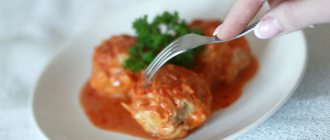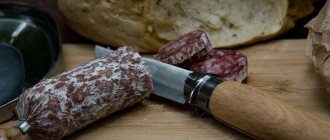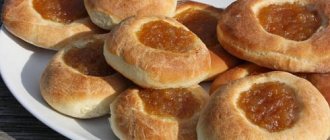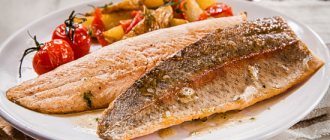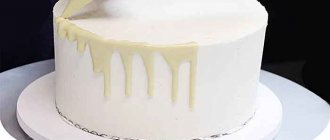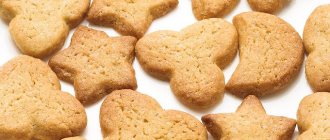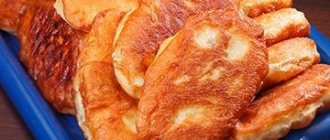“Bread is the head of everything.” People absorb this proverb with their mother's milk. The most important product in the diet of our ancestors for centuries has always been black bread.
People began to grow cereals more than two thousand years ago. Wheat was the first to be cultivated, but it turned out to be a whimsical plant. In the harsh climate of many Slavic states, the best harvests were rye, oats and barley.
Therefore, people baked bread from barley, rye and oat flour. In Rus', black bread from rye flour began to be baked from the first decades of the eleventh century. Housewives strictly kept their bread recipes, which were passed on from mother to daughter.
The type of black bread depends on the type of rye flour. Black bread is baked from sifted rye flour, from peeled flour and from wallpaper flour. There are also several types of rye bread - black plain bread, Moscow and custard. The most famous variety of black bread is Borodinsky. It is often made into a brick shape and topped with coriander and cumin seeds.
What is the calorie content of bread? Borodinsky and other bread varieties
Even in our childhood, we were always taught that the most important dish on the table is bread. So even if our tables are laden with the most expensive and exquisite dishes, the table will not look complete and complete if there is no bread on it.
What is the calorie content of Borodino bread?
Per 100 grams of product, its calorie content is 208 kcal.
Calorie content of 1 piece of Borodino bread
A piece of black Borodino bread weighs on average 50 grams. From these indicators we can draw the following conclusion about the calorie content in it.
There are 104 kcal in 1 (one) piece of Borodino bread.
The calorie content of 1 piece of Borodino bread with butter (5 grams) is 141 kcal.
The calorie content of 1 piece of Borodino bread with butter (5 grams) and cheese (20 grams) is 180 kcal.
Borodino bread crackers - calorie content
Per 100 grams of product = 330 kcal.
In 1 (one) piece (35 grams) = 116 kcal.
Compound
- rye flour 80%;
- wheat flour (grade 2) 15%;
- sugar + salt;
- rye malt 5%;
- leaven;
- syrup;
- various spices (cumin, spices, etc.).
Calorie content of simple black bread
On average: 200 kcal per 100 grams of product. (One piece contains 66 kcal.)
A piece of bread with butter
A piece of bread (35-40 grams) + butter (5 grams) = 103 kcal.
Piece of bread with butter and cheese
A piece of bread (35-40 grams) + butter (5 grams) + cheese (20 grams) = 170 kcal.
Piece of bread with butter and sausage
A piece of bread (35-40 grams) + butter (5 grams) + boiled sausage (20 grams) = 165 kcal.
Calorie content of black bread crackers
335 kcal per 100 grams of product.
Yeast-free black bread has less calories
177 kcal. per 100 grams of product.
How many calories does regular white bread have?
On average: 270 kcal per 100 grams of product. (1 piece contains 90 kcal.)
Calorie content of white bread crackers
350 kcal per 100 grams of product.
White unleavened bread has lower calorie content
290 kcal. per 100 grams of product.
What is the meaning of bread?
Yes, the fact is that in its composition you can find any useful element that our body needs.
So if you refuse to eat bread, any kind of bread, in your diet, you will lose a valuable source of most nutrients.
Refusal to eat bread
Most dietary guidelines say that bread should be eliminated completely because it is too high in calories.
However, modern cooking is so diverse that you don’t have to choose the most nutritious bread. You can easily replace it with a flour product of lower calorie content.
There are often diets where you are allowed to eat whatever you want in a day, but there is a certain amount of calories that you should not exceed. It is with such diets that you can eat bread.
The harm and benefits of bread
If it is so useful, what is its harm? The fact is that the most useful substances are contained in wheat grains, namely in their shells and germs. However, when we grind these grains, all these beneficial properties are instantly destroyed. All that remains in the flour is a terribly large amount of starch, and with it more calories.
Of course, one cannot argue with the fact that bread made from premium flour is very tasty and pleasant, delicate in taste, but it is devoid of its benefits. This is especially true for white bread, which directly supplies only calories and excess weight to our body.
More than one thousand years ago, people started baking bread!
Over time, people learned to use not only the grain itself, but also everything that belonged to it before, the bran that remained after the grain was ground.
If you have seen rye bread, it is made from rye flour. In fact, this bread is not black, but gray.
The positive properties of this bread include the fact that it is digested slowly, and it contains much more useful substances than, say, white bread. So rye bread already has much fewer calories.
But the most benefits come from bran and black bread!
Thanks to bran in the body, these products absorb toxins and allergens, the body's immune strength increases, and the fiber they contain helps to more completely cleanse the contents of the stomach. So in bran bread you will find much more vitamins for the body and other useful substances.
Nutritionists' opinions on bread
In principle, we understand the nutritionist’s logic regarding white and brown bread - since white bread is much more caloric than black bread, then we need to eat the one that has less calories. After all, excess calories are quite reasonably stored in our body in the form of fat because the body is not able to digest such a large number of calories.
However, there is one But!
All nutritionists forget or simply keep silent for some unknown reason that black bread contains a large amount of vitamin B, which is quite useful and insidious. The fact is that in addition to its direct benefits and work (it helps to monitor the normal functioning of the lungs and heart), this vitamin also slows down the process of fat breakdown.
The more this vitamin accumulates in the body, the more fat you will have. Namely, coarsely ground black bread contains the most of this vitamin. And nutritionists and other experts advise eating as much of this bread as possible. It is especially often recommended to eat this bread if you are obese in order to significantly reduce the level of calories entering the body.
So it is quite natural that people get fat evenly from both white and black bread.
We recommend that you eat all types of bread, but little by little!
And the thickness of a normal piece of bread should not exceed the thickness of a blotter. By the way, as for the calorie content of one piece of bread, you can easily calculate it yourself. One piece of bread weighs about fifty grams. And for all one hundred grams you can eat about two (or even three) pieces of bread.
The only thing we don’t recommend is eating very fresh white bread. This bread contains various harmful substances. Let it sit for a couple of days until it gets a little stale, and only then eat it.
Source: https://ladyeve.ru/kalorii/kakaya-kalorijnost-v-kuske-hleba-kalorii-v-chernom-belom-hlebe.html
Selection rules
To select a high-quality product on store shelves, you must first decide on the type of product.
A pure rye product is not suitable for everyone, so most people opt for the rye-wheat variety. An important role in choosing a product is played by taste, namely, various types of additives. Having chosen the most suitable type of product, it is advisable to inspect the appearance of the baked goods for defects or color changes, which indicate the degree of baking of the product.
How long does rye bread remain usable? The package label contains this important information. It shows the date of manufacture, shelf life, composition, calorie content and nutritional value. The residence time of bread in stores ranges from 24 to 36 hours from the moment of baking.
Calorie content of bread and its use for weight loss
When losing weight, you cannot completely exclude all types of bread products. During weight loss, it is necessary to prevent deficiency of vitamins and minerals in the body. When limiting the consumption of certain foods, a person begins to receive less nutritional components.
Nutritionists insist that eating bread is necessary. It is rich in a lot of vitamins and chemicals. However, not all types of food can be eaten while losing weight. The best solution is to make your own bread.
Calorie content
Wheat bread contains 213.6 kilocalories. The nutritional value, or the content of proteins, fats and carbohydrates, is 7.6/0.9/46.7 g. One bun (usually weighing 400 g) contains 1060 kcal. On average, 1 piece of bread contains from 50 to 70 calories.
The exact value of how many calories will be added can be found out by weighing 1 slice. Below are the calorie numbers depending on the type (per 100 grams):
| Types of flour products | Number of calories (kcal) | Composition of BJU (g) |
| White | 253,66 | 8,04/2,66/48,01 |
| Black | 208,29 | 7,12/1,57/39,55 |
| Rye | 250 | 13,0/3,0/40 |
| Grey | 254,66 | 8,97/2,71/48,24 |
| Borodinsky | 208 | 6,9/1 ,3/40,9 |
| Yeast-free | 221 | 6,9/1,2/43,4 |
| Bogorodsky | 220,8 | 6,8/1,05/45,74 |
| With bran | 227 | 7,5/1,3/45,2 |
| With buckwheat flour | 288 | 7,1/2,5/45,8 |
| Dietary | 214,9 | 5,6/1,9/45,3 |
Bread crumbs contain 331 kcal, 11.2 g of protein, 1.4 g of fat and 72.2 g of carbohydrates. Borodino contains the least amount of calories.
Composition and beneficial properties
When consuming bread products, the body receives fiber, which helps improve the functioning of the digestive organs. When losing weight, a person experiences stress. The cereal product normalizes the nervous system.
Therefore, you should not completely give up bread. The most useful is rye. It contains many healing components, as well as the following vitamins:
- retinol;
- tocopherol;
- lipophilic compounds (vitamin K).
Chemical composition of bread:
- iodine;
- sodium;
- manganese;
- chlorine;
- potassium;
- zinc;
- silicon;
- selenium;
- magnesium;
- copper;
- cobalt.
If you deprive the body of the minerals and vitamins found in bread, this will lead to increased fatigue, short temper, and depressive disorders.
Slow carbohydrates and amino acids stimulate muscle growth. Other beneficial properties of flour products include:
- lack of fast carbohydrates;
- content of substances necessary for the heart (magnesium, potassium);
- high energy value;
- long-term absorption.
Bread for weight loss
White bread made from premium flour contains a lot of starch and calories. After consuming such products, insulin is produced and a sharp drop in sugar occurs, which causes an acute feeling of hunger. As a result, a person begins to eat more and overeating occurs.
To lose weight, you need to choose baked goods with the following additives (the listed varieties contain a lot of healthy fiber):
- linen;
- buckwheat grains;
- sunflower seeds;
- millet;
- oats;
- carrot;
- onion;
- pumpkin;
- paprika.
Black and gray bread with rye flour is absorbed more slowly by the body. It is useful to eat rye bread with other products that are present in a weight loss diet. This way saturation will happen faster.
By consuming flour products, you can cleanse the body of harmful metabolic products and carcinogens; bread is also low in calories. You can reduce the calorie content even further if you buy it from flour made from legume grains, such as peas and corn.
How to replace the product
Bread can be replaced with fruits, fresh vegetables and herbs. But these foods will not make you feel full.
If necessary, you can replace the bread:
- biscuits;
- bread;
- bran.
Cooking recipes
Dietary products can be prepared at home. To do this you need to follow the recipes:
| Product | Ingredients | Cooking method |
| With bran |
|
|
| By leaps and bounds |
|
|
| With oatmeal |
|
|
| With cheese and garlic |
|
|
Before eating homemade bread, you need to wait until it cools. To lose weight, you need to eat 10 pieces with low-calorie foods (for example, a vegetable salad). You can make sandwiches from:
- lean meat;
- low-fat cottage cheese;
- birds;
- butter.
You should add sugar-free yogurt and fermented milk products to your diet. The duration of this diet is 14 days. To get out of it slowly and not gain extra pounds again, you should replace bread with products such as:
- muesli - 2-3 spoons;
- boiled beans - 250 g;
- corn - 1 cob;
- pasta - 250 g;
- boiled potatoes - 1 pc.
Source: https://tonustela.net/calorific-value/bread/hleb.html
Bread "Honey"
So, we have already decided that bread can be eaten in moderation, no more than 50 grams per day, even by those who are struggling with excess weight. If you question the quality and naturalness of store-bought baked goods, you can prepare bread in your home kitchen. There is nothing complicated about it. The process, however, is painstaking, since you will have to spend effort on kneading and time on infusing it.
Honey will give rye bread an incredible aroma and an appetizing crust. Let's get started?
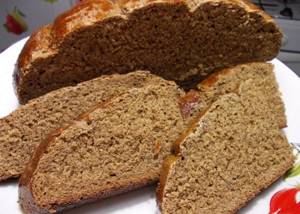
Ingredients:
- honey – 75 ml;
- refined vegetable oil - three tablespoons. spoons;
- granulated instant yeast - one teaspoon. spoon;
- rye flour - eight tables. spoon;
- malt - three tables. spoons;
- premium wheat flour - three tablespoons. spoons;
- filtered water – 250 ml;
- salt – ½ teaspoon. spoons.
Preparation:
- We'll start by preparing the necessary products. Pre-heat the water, but not too much, otherwise the yeast will not work.
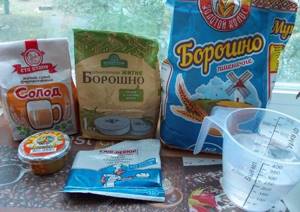
- Dilute honey in warm water. Stir these components until the beekeeping product is completely dissolved. The liquid should acquire a uniform consistency.

- First, let's start preparing the dough. Pour honey water into a bowl with high sides. Add six tablespoons of wheat flour and granulated instant yeast to it.
- Stir and leave for a third of an hour.
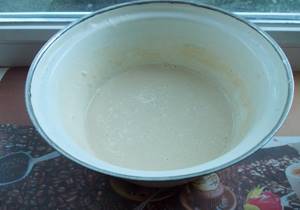
- The prepared dough will approximately double in volume.
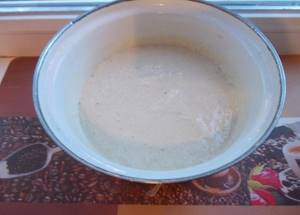
- Then add the remaining ingredients and begin kneading the dough.

- When the dough becomes difficult to mix with a spatula, transfer it to the table and continue kneading by hand.
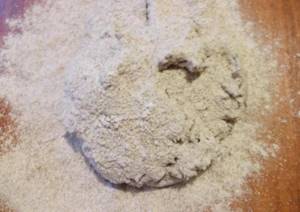
- Pour refined vegetable oil over the dough and distribute it evenly.
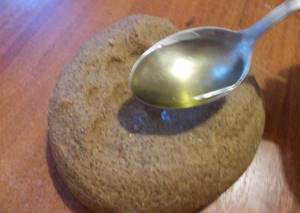
- We send the dough to a secluded place for one hour.
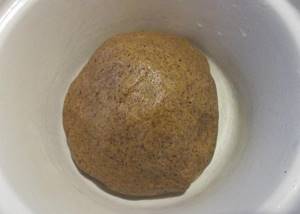
- After the allotted time, the piece of dough will approximately double in volume.

- We make parallel cuts on top and brush the bread with beaten egg yolk.
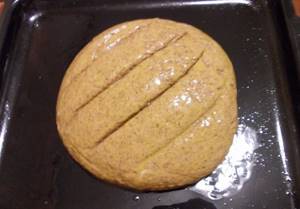
- Place in the oven. We will bake at a temperature of 180-200° for 40 minutes.
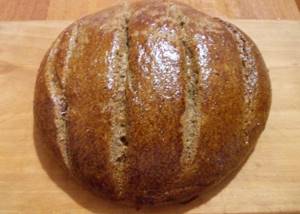
- Before serving, cool the bread and cut into slices.
How many calories are in bread
Bread is on every table in the house, where the traditions of cooking and delicious food are honored. Most citizens who watch their figure refuse baked goods and in vain.
You cannot refuse the product, since it contains a large amount of healthy carbohydrates, proteins and fats.
It is only important to study how many calories are in bread in order to understand in what quantities it can be consumed safely for your own figure.
Bread contains many vitamins B and PP, choline and dietary fiber. All of them are responsible for enriching the body with useful substances and building muscle tissue.
Thanks to the large amount of protein and carbohydrates, rapid saturation occurs, including proper brain function and metabolism, which has a positive effect on energy costs. The calorie content of bread is high, but it is a fast carbohydrate that is required to give a person strength.
To maintain your figure, it is enough to choose the right type of bakery product for regular use. Next, the energy value of all types of bakery products made on the basis of the usual white or black bread will be examined in detail.
Energy value of bread
At the moment, there are about 100 varieties of baked goods, which can be roughly divided into white and black bread. You can make different variations of each to change the taste - make crispy baguettes or dried crackers. The calorie content also changes depending on the cooking method.
A standard Family loaf contains 900 g of product. On average, its calorie content is 270-310 kcal per 100 grams, respectively, a loaf is about 2 thousand kilocalories. 1 slice contains about 100 kcal - this is an insignificant caloric value, so you can consume the product regardless of your desire to maintain your figure.
Please note: Bread is a fast carbohydrate, therefore, consuming it in large quantities is not recommended - the carbohydrates that enter the body will be processed into fat cells, which are difficult to get rid of. But 2 slices of bread will not harm your figure, but will only saturate the body with useful microelements.
loaf
A loaf is a type of white bread, for the production of which a large amount of yeast and premium flour are used. The product turns out light and airy. White bread with the shape and structure of a loaf contains about 1100 kcal for a whole product weighing 400 grams.
It turns out that the calorie content of bread per 100 grams is 275 kcal. One piece of bread will contain about 100 kcal, but eating it will have a worse effect on your figure. Everything is explained by the yeast and the composition of the flour used for baking. If you want to enjoy white wheat bread, it is better to give preference to croutons or crackers.
White wheat
A loaf of white wheat bread contains only 600 grams and 1400 kilocalories. The energy value per 100 grams is about 300 kilocalories. The nutritional value increases in accordance with the flour used - coarse grinding provides greater energy value, but at the same time, it is better absorbed by the body, and the calories consumed are less processed into fat cells.
Rye
This bread is made from rye flour, so its calorie content is low. One loaf, for example, of Borodino bread contains only 700 g and about 200 kilocalories per 100 g of product.
Practical advice: Black bread contains a lot of fiber, which is why it is recommended for people with poor functioning of the gastrointestinal tract. Rye bread has a low glycemic index due to the low amount of carbohydrates it contains - about 45% of the total composition. As a result, it is recommended for use by people with diabetes.
With bran
The energy value of the product is only 250 kcal per 100 g of product. Despite the average calorie content, a bran product can boast a large number of beneficial properties:
- the content of bran helps remove waste and toxins from the body;
- the presence of bran helps neutralize toxins, which increases immunity;
- the body is additionally saturated with plant proteins.
Bran is contraindicated for people with stomach ulcers and intestinal diseases, so it is better for them to avoid this type of baked product. Doctors assure that 1 piece of such bread or crouton will not provoke an exacerbation of the existing pathology.
It is recommended to consume croutons from the presented product for citizens with diabetes mellitus, cholelithiasis, atherosclerosis, hypertension and obesity. The most famous rye bakery products include Darnitsky, which has several flavors in accordance with the manufacturer’s recipe used - it is either gray or dark brown.
Toast
Croutons are not used as often in Russia as abroad, but their benefits when eaten for breakfast are obvious. There are about 370 kilocalories per 100 g of product. You should not assume that croutons have more calories - during the process of cooking bread in a toaster, the product dries out, which means the weight of one piece decreases by about 2 times.
It should also be noted that to get a feeling of fullness, it will be enough to consume only 1 piece, while with fresh baked goods a larger amount is required. This is not a fried bread, so the calories will not increase during cooking.
The most complete list is presented in the table.
| BREAD | KCAL PER 100 G | KCAL PER 1 PIECE |
| White | 225 | ~40g, 90 |
| Black | 216 | ~40g, 87 |
| Grey | 280 | ~40g, 112 |
| Rye with butter | 297 | ~30g, 89 |
| Toast | 312 | ~15y, 47 |
| Brown bread crackers | 295 | ~10g, 30 |
| Bread | 320 | ~10g, 32 |
Making croutons from a loaf
Croutons can be cooked in the oven without oil. To reduce calorie content, it is better to take products made from wholemeal flour so that the crackers are better absorbed by the body.
To prepare, you need to do the following:
- Cut a small amount of product into cubes.
- Mix them with finely chopped herbs - it is better to take dill and parsley.
- Place the product on a baking sheet - you can dry it, you can pre-grease it with oil. In the second case, the nutritional value of the cooked croutons will increase.
- Sprinkle the chopped loaf with spices and salt.
- Place the baking sheet in the oven at 170 degrees for 15 minutes.
- To prevent the loaf or wholemeal product from burning, turn it over periodically.
- Next, remove the crackers from the oven and sprinkle them with water.
- Place the loaf in the oven again for 5-7 minutes.
- Remove the product from the oven and leave it to cool.
Such crackers contain no more than 330 kcal per 100 g. They are recommended to be added to soups and other dishes.
The benefits of bread product
Having considered the energy value of various types of baked goods, it is necessary to present its benefits so that readers can decide whether to consume it daily. The benefits of the product are indicated by the composition presented in the table.
| VITAMINS | CONTENTS, MG | MINERALS | CONTENTS, MG |
| Kholin | 60 | Chlorine | 680 |
| Vitamin E | 2,3 | Sodium | 400 |
| Vitamin B3 | 2 | Potassium | 244 |
| Vitamin B5 | 0,55 | Phosphorus | 194 |
| Vitamin B6 | 0,2 | Magnesium | 57 |
| Vitamin B2 | 0,09 | Sulfur | 56 |
| Vitamin B9 | 0,03 | Calcium | 33 |
| Vitamin B1 | 0,02 | Silicon | 5,5 |
| Vitamin A | 0,003 | Iron | 4,5 |
| Vitamin H | 0,002 | Zinc | 1 |
The benefits of bread lie in the content of healthy amino acids, complex carbohydrates and fiber. The substances presented can normalize intestinal function and reduce cholesterol levels in human blood.
But the consumption of baked goods should be in moderation, because otherwise you may encounter increased intestinal gas formation. This in most cases occurs when consuming large quantities of wheat or products with bran.
| Name | Calorie content per 100 g |
| Wheat flour loaf | 235 kcal |
| Pancake flour (pancake flour) | 333 kcal |
| Pancake with cottage cheese | 162 kcal |
| Pancake with mushrooms | 200 kcal |
| Pancake with meat | 186 kcal |
| Pancake with chicken and rice | 169 kcal |
| Butter bun | 300 kcal |
| Hot dog bun | 266 kcal |
| Burekasi with cabbage | 393 kcal |
| Burekas with liver | 404 kcal |
| Burekas with jam | 412 kcal |
| Burekas with meat | 373 kcal |
| Burekasi with onion and egg | 354 kcal |
| Croissant with caramel | 298 kcal |
| Croissant with cabbage | 377 kcal |
| Coffee croissant | 346 kcal |
| Wheat flour | 334 kcal |
| Rye bran | 212 kcal |
| Wheat bran | 260 kcal |
| Blueberry pie (pie with blueberries) | 196 kcal |
| Strawberry pie (pie with strawberries) | 221 kcal |
| Pie with lingonberries | 242 kcal |
| Fried pie with liver | 336 kcal |
| Pie fried with onion and egg | 248 kcal |
| Pie with cabbage | 246 kcal |
| Pie with fish | 227 kcal |
| Pie in Ural style | 178 kcal |
| Drying | 341 kcal |
| Cream crackers | 398 kcal |
| Rye crackers (Finnish) | 320 kcal |
| Wheat-oat crackers (well done bread) | 295 kcal |
| Wheat-buckwheat crackers (well done bread) | 280 kcal |
| Puff pastry without yeast | 487 kcal |
| Crackers with cranberries (Doctor Korner) | 330 kcal |
| Cereal crackers (Doctor Korner) | 312 kcal |
| Black bread | 214 kcal |
| White wheat bread | 223 kcal |
| Borodino bread | 208 kcal |
| Chusovsky dark bread | 212 kcal |
| Malt bread | 281 kcal |
| Kaiser bread | 271 kcal |
| Corn bread with seeds | 290 kcal |
| Rye bread made from peeled flour | 189 kcal |
| Rye bread made from wallpaper flour | 181 kcal |
Source: https://diets.guru/calories/skolko-kalorij-v-hlebe/
The benefits of bread product
The product is a “supplier” of vitamins such as A, E, list B, PP and others. It contains macroelements:
- chlorine;
- sodium;
- potassium;
- phosphorus;
- sulfur;
- silicon;
- calcium.
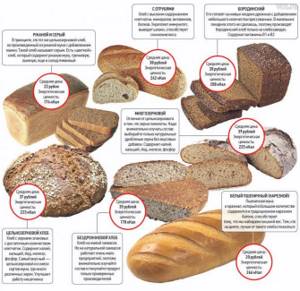
It also contains trace elements: iron, zinc, copper and manganese.
Based on the composition of nutrients, we can say that this bakery product is necessary for the body. But which variety is best to consume, everyone chooses for themselves individually, considering the caloric content of the given varieties. White wheat made from fine flour does not contain any beneficial substances.
It also contains a lot of vegetable protein and Omega-6 fatty acids. Due to the fiber present in it, the product takes a long time to digest and assimilate, which keeps you feeling full for a long time. And this is an important component in dietary nutrition.
How many calories are in black bread - 1 piece: with butter, with cheese, can you eat it while on a diet?
There are very few calories in 1 piece of the product - per 100 grams of the familiar Borodinsky there are only 208 calories. How much energy value is found in other, more exotic varieties can be seen from the list below: 1. “Darnitsky” - 206. 2. “Ukrainian” - 198. 3. Whole grain from rye flour with malt - 198.
These are the most “dietary” types of product with the lowest fat and carbohydrate content. There are other varieties of the popular product with a higher content of microelements, which not only affect the deposition of fat reserves, but also charge a person with energy. These are yeast-free, rye and gray.
Their preparation involves wholemeal flour, which slows down the process of breaking down starch from raw materials in the body.
Important!
A healthy product is obtained only from first-grade coarse flour. It contains much more useful microelements that our body really needs. Excellent butter products are produced from the highest grade raw materials, which mainly contain only starch and nitrogenous compounds. They, in turn, are deposited on the sides with additional folds. Thus, no matter how many calories there are in 1 piece of black bread, it is much healthier than a wheat product made from refined flour.
How does the composition of a product change with additives?
When calculating the calorie content of lunch or breakfast, you should take into account the weight of 1 piece of black bread; it fluctuates around 40 grams. An important point in such manipulations remains the presence of seeds or grains and how many calories they add to a standard product.
If, in the process of calculating your diet, you want to eat a sandwich with butter, the energy value of a slice of black bread increases by 47 calories. In this case, the additive layer should not exceed a weight of 7 grams. The number of calories from a piece of cheese weighing 18 grams also increases. With this addition, the sandwich will become even “heavier”, adding 62 calories to the diet.
And considering that one sandwich is not enough for a person who is used to eating a lot, the weight of what is eaten increases proportionally.
Important!
Brown bread should not be eaten by people with high acidity and gastritis, ulcers and other problems of the gastrointestinal tract. In addition, the product is not a main component of various diets, so it should be limited if you are overweight. Thus, 1 piece of black bread will not only replenish your energy supply for the whole day, but will also help you more easily endure significant dietary restrictions. Knowing how many calories it contains, it is easier to distribute physical activity during active training. Therefore, black bread can be safely consumed with butter or cheese, without exceeding the amount of this useful additive in the diet.
Options with breadcrumbs
Contrary to the advertising slogans of marketers, the calorie content of 1 piece of black bread does not decrease due to drying it. No matter how much manufacturers describe in their booklets the benefits of this type of product, in reality it is no different from fresh baked goods. This fact applies to all types of bread, because when dried, the amount of starch in it remains the same.
Neither fats nor carbohydrates leave such a product, and in combination with preservatives and flavoring additives, crackers become a very dubious replacement for a regular product. Fried types of crackers are even less dietary. Their production involves margarine, vegetable oils of dubious quality and oil-containing substitutes.
Instead of being beneficial and reducing your waistline, such food products bring a whole bunch of health problems: • exacerbation of diseases of the gastrointestinal tract; • additional stress on the kidneys and liver due to chemical additives; • disruption of intestinal function due to an excess of dry substances, and so on. The calorie content of homemade croutons often exceeds 40 kcal. per 100 grams of finished product.
And this is a quarter of the daily norm for an adult working person. As we see, wheat bread, which was considered a privileged food by our ancestors, has long become a “harmful product” for modern people. Whereas 1 piece of black bread, considering how many calories it contains, will not bring any special problems, even if you make a sandwich with butter or cheese out of it.
Therefore, a small amount of the product can and should be eaten with any diet. Posted by: Anaid [Offline]
Beef liver in sour cream with onions
- beef liver; - salt;
– black or fragrant ground...
Meat zrazy with egg and cheese in the oven
– minced turkey; - egg; - tomato;
- onions...
Source: https://dieta-prosto.ru/b834/Skolqko_kalorij_v_1_kusochke_chernogo_hleba
Composition of nutrients, BJU
| For quantity: 1 piece | ||
| Calories – 82 | Calories from fat – 13 | |
| BJU | ||
| Total fat content | 1.49g | |
| Saturated | 0.49g | |
| Polyunsaturated | 0.43g | |
| Monounsaturated | 0.37g | |
| Cholesterol | 0.31mg | |
| Total carbohydrate content | 14.21 | |
| Dietary fiber | 2.21g | |
| Sugar | 1.61g | |
| Squirrels | 1.74g | |
| Vitamins and microelements | ||
| A – 0.17 µg | C – 0.11 mg | |
| B-6 – 0.05 mg | B-12 – 0µg | |
| D – 0µg | E – 0.19 mg | |
| Calcium 40.57 µg | Iron 0.81 mg | |
| Magnesium 15.73 mg | Zinc 0.35mg | |
| Potassium 51.24 mg | Sodium 118.34 mg | |
Distribution of calories for BJU: | ||
How many calories are in bread and butter - white and rye?
The question of how many calories are in bread and butter is quite controversial. It is important to consider several factors here - the type of baked goods, the percentage of fat in the butter. Let's break everything down into pieces.
How many calories are in a piece of bread and butter?
First, let's figure out how many calories are in white bread with butter. A classic sandwich made from white bread with a thin layer of butter (with a fat content of 82.5%) has an energy value of one hundred and fifty-four kilocalories. We calculate based on the fact that for one sandwich we take thirty grams of bread and ten grams of butter.
This figure can be reduced if you take rye pastries instead of white bread. The calorie content of an ordinary loaf of such bread is one hundred and sixty-five kilocalories, and a piece of thirty grams is fifty. How many calories are in black bread with butter? About seventy-five kilocalories.
On a note! Do you stick to a healthy menu? Make sandwiches with bran bread or whole grain bread.
Attention! If you supplement a sandwich with butter with additional components, for example, a slice of cheese or a piece of sausage, its energy value becomes higher.
Bread for the diet menu
We will prepare dietary bread with sour milk and without adding yeast. And for taste, add pumpkin seeds and spices to it.
Ingredients:
- eggs - two pieces;
- sour milk - two glasses;
- salt;
- black pepper;
- rye flour - 0.7 kg;
- tarragon seeds - one teaspoon;
- purified vegetable oil – one glass;
- soda – one teaspoon;
- dried greens;
- pumpkin seeds.
On a note! Instead of sour milk, you can use kefir or classic low-fat yogurt as a base for bread.
Preparation:
- Beat eggs into a blender container.
- Add sour milk to them.
- Add black pepper and salt.
- Now add a third of the rye flour to the blender container.
- Let's run the blender for a minute. We need all components to “connect” with each other.
- Add tarragon seeds.
- Without stirring the mixture, add half a glass of purified vegetable oil. By the way, it will be delicious if you use grape oil.
- Let's work with the blender for a couple of minutes so that the mass acquires a uniform structure.
- Let's introduce soda. First extinguish it with lemon juice or vinegar.
- Add greens. It is better to use dried parsley.
- Stir the mixture with a blender until it becomes a homogeneous structure.
- Add pumpkin seeds.
- Now we need to work with our hands. Stir pumpkin seeds into the base.
- Dust the work surface with flour. Let's lay out our base on it.
- Knead the base, slowly adding the remaining flour to it.
The finished base should not stick. Do not add more flour than recommended. To achieve the desired structure, gradually add vegetable oil. It will make the bread elastic and soft. - Let the dough sit for half an hour until it rises slightly.
- Then line the baking sheet with a sheet of baking paper.
- From the dough piece we form small-sized cods. Place them on a baking sheet.
- Using a knife, make cuts on the workpieces. The movements should be pressing.
- Warm up the oven for literally five minutes. We place our preparations in it.
- The oven must be “accelerated” to two hundred and ten degrees.
While it warms up, the bread will rise slightly. - We bake the bread for half an hour - forty minutes.
Homemade butter - quick and easy!
Store-bought oil, of course, can be of high quality, but you can hardly find such a product better than homemade one. It's easy to prepare. For this we only need sour cream. Choose a homemade product with a fat content of forty-five to fifty-five percent.
Harm
The benefits are undeniable, but the product can also cause harm to the body. Fine flour varieties and loaves have a high glycemic index. Therefore, when eating on a diet, it is better not to eat them at all. These varieties contain sodium, which helps retain fluid in the body.
Fatty acids in white and loaves lose all their beneficial properties during the cooking process. Vegetable protein is not represented by a complete list of amino acids. It is healthier to eat rye or black; they retain the necessary substances in greater quantities. Knowing how many calories are in rye bread, you can eat it without fear of harming your health.
Some foods cannot be eaten without baked goods, such as butter or herring. The usual sandwiches with sausage and cheese are considered unhealthful. Toasts, bread in eggs and similar dishes that are common for breakfast have a high energy value, but for the start of the day this is the norm, so you can periodically include such variations in the diet. They are quickly consumed during work.
How many calories are in black bread - in 1 piece, breadcrumbs?
Did you know that today there are about 300 different types of bread? Naturally, with such a wealth of choice, the buyer is quite spoiled. However, the next time you buy bread, you should take a closer look at the ingredients to choose a product for a healthy diet. Let's consider how many calories are in black bread.
Black bread can be classified as a special variety because it is baked mainly from rye flour. It is this grain that gives the bread its characteristic dark color.
From a dietary point of view, rye bread, like other varieties, contains a large amount of carbohydrates.
But at the same time, it also stands out for its high fiber content: almost 8 g per 100 g of product, which is almost 2 times more than in a traditional white loaf of bread.
How many calories are in a piece of black bread? If we talk about the energy component, then 100 g of rye bread provides about 240 Kcal.
It is clear that the reference to 100 grams does not mean anything to many, since, probably, no one weighs a portion of bread before eating it.
Therefore, let’s try to visualize and move on to neatly cut pieces of bread on the dining table, familiar to everyone.
How many calories do you think are in 1 piece of black bread? There is no need to guess, because such data exists, and we will be happy to share this information with you:
- a slice of sandwich bread contains 18 kcal;
- a standard medium-sized piece for lunch weighing about 26 g – 67 Kcal;
- bread slice for toast – 31 Kcal;
- thick piece of bread – 83 Kcal.
Many people like rye crackers. How many calories are in black bread crumbs? 100 grams of this product contains about 366 kcal. Thus, one cracker from a standard slice of bread will provide you with energy for as much as 37 kcal.
Rye bread – risk or benefit?
Did you know that the content of rye flour in a recipe for black bread should not be less than 65%? And if it is less, between 10-35%, then although such bread is called rye, it will no longer be black, but gray.
To make black bread, rye flour is constantly mixed with wheat flour. Otherwise the dough will not rise.
This is one of the disadvantages of rye bread, since the low content of white flour is easier to digest for people sensitive to gluten.
However, rye bread remains one of the least calorie-rich among whole grain varieties. And its high fiber content makes it especially attractive for nutrition when losing weight, because plant fibers, dissolving in water, form a kind of gel in the intestines, as a result of which we do not feel hungry for a long time.
But that's not all: fiber also slows the absorption of glucose into the blood, which is why rye bread has a glycemic index of 65, which is considered average. But the lower it is, the less it causes surges in insulin, which promotes the accumulation of fat in the cells of the body’s tissues.
In a word, rye bread is an excellent alternative to white bread and has many advantages:
- keeps fresh for 3-4 days;
- it is very tasty;
- ideal for breakfast, as a slice of bread along with a glass of orange juice provides a lot of energy, fiber and vitamins;
- black bread contains an amazing combination of iron and B vitamins, which promotes good digestion;
- Constant consumption of rye bread will help avoid the accumulation of excess weight and obesity.
How to eat properly
- Try not to eat bread while it is hot, as the increased stickiness will make it very difficult to digest. This can cause exacerbation of gastritis, upset, or constipation. If you suffer from diseases of the gastrointestinal tract, eat it slightly dried. It has less of a juice effect (this is dangerous with high acidity) compared to fresh.
- Combination with potatoes is not recommended at all, as these products have a high starch content.
- It is better to eat black with meat, fish, cottage cheese and butter.
- Pairs well with fresh vegetables.
- Don't eat moldy bread. The fact is that mold contains more than a hundred toxic compounds that can cause serious illnesses, including cancer. Therefore, it is better to throw away any moldy products immediately.
- To avoid gaining weight, eat no more than 100 g of rye and rye-wheat bread per day. White - no more than 80 g per day.

